Not to be snide: it is of course art whose point, or much of whose point, is the awareness of the passing of time. I think I first started thinking about this on learning about Japanese traditional art forms, especially the Noh theater; soon enough this was associated with the music of John Cage and, especially, Morton Feldman.
Well, anyway, PICA has been running a festival of Time-Based Art for a number of years now, and the festival was on last week while we were visiting that fascinating city. After more than twenty years of retirement I still prefer not to go to performances or galleries casually, and I hadn't planned on going to any of these. But three events were irresistible.
On Saturday we tagged along with Khris Soden on his Portland Tour of Tilburg. We and about thirty other people followed him as he led us, walking backward most of the time and holding a little paper Dutch flag aloft, along forty blocks or so through downtown Portland. Along the way he discussed the buildings, sculpture, fountains and streets we were "seeing" — "seeing" in quotes because while we were looking at Portland he was describing Tilburg, Netherlands.
Some of us had booklets of photos of the described places (some of them) in Tilburg. They were helpful, I suppose, but soon enough I was more interested in the cognitive dissonance between what I was actually seeing and what I was hearing being described. It helped, of course, that I'm quite familiar with the generic appearance of Dutch cities; their parks, traffic, cafés, shops, architecture, and the like — even though I am not at all familiar with Tilburg, a fairly large city in Brabant, the part of the Netherlands I know the least.
Today (Friday, Sept. 19) my granddaughter Grace is taking Soden's tour of Portland in Tilburg; I wish I could have been with her. What Soden does is part sculpture, part walking, part dance; wholly active, wholly contemplative. I'll be thinking about it for a while.
SUNDAY WE ATTENDED an event that was pure Dance, The City Dance of Lawrence and Anna Halprin, with choreographers Linda K. Johnson, Cydney Wilkes, Linda Austin, and Tere Mathern, writer Randy Gragg, and the Third Angle New Music Ensemble, a dozen or so musicians, playing music by Pauline Oliveros, Morton Subotnick, and Terry Riley.
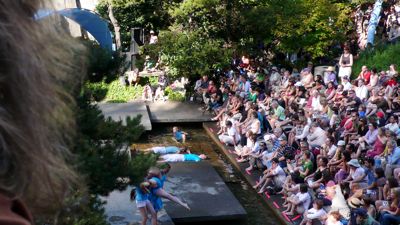
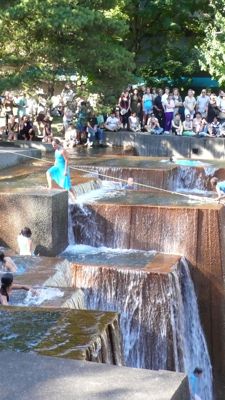 the end ropes were thrown down over the lips of the cascades and dancers climbed them to the lips of the upper fountains, where they threw themselves into the pools; dance and athletics have rarely been so beautifully, so strikingly combined — and in a setting that also includes terrain, plantings, and the audience awareness of itself as participant.
the end ropes were thrown down over the lips of the cascades and dancers climbed them to the lips of the upper fountains, where they threw themselves into the pools; dance and athletics have rarely been so beautifully, so strikingly combined — and in a setting that also includes terrain, plantings, and the audience awareness of itself as participant.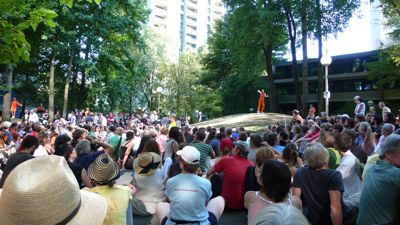
From here, a number of ushers quietly and tactfully guided the audience to the next stop, Pettygrove Park: three fairly small circular berms set among broad-leaved trees. No fountain; just quiet land and trees. Musicians — flute, clarinet, trumpet, French horn, violins, viola, cello, bass — were scattered widely within the landscape, and dancers appeared, holding positions, then coming to life. The music was by Pauline Oliveros, and it was delicious. Hearing unpredictable but logically appearing sounds, from conventional instruments conventionally played, in an outdoors public space, is one of the great pleasures of civic musical life: it binds the audience together with itself, its community, and the traditions of its culture. And seeing the music punctuated and "interpreted" — not only the music, but the park setting as well — knits all these factors together.
At Keller Fountain we'd been on the extreme margin of the audience, hardly able to see the dancers; here we were at the center, the dancers on their berms around us; Pauline's music, with occasional called-out words and phrases from writings of Lawrence Halprin, somehow both floating and focussing the audience into a gentle fabric of urban sound. Distant traffic and more local natural sound contributed, as did uncontrollable small motions within the audience.
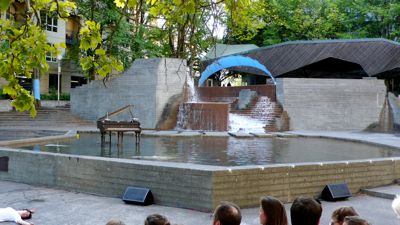
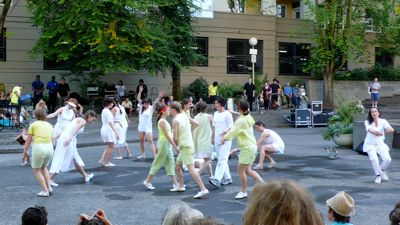
The music here was Terry Riley's, and before it was over a musician had waded to that piano and begun to hammer out the familiar octave "C"'s that begin his equally groundbreaking In C. Before the act was over dancers had taken to the back wall of the fountain, methodically splashing cupfuls of water against the concrete wall, claiming Action Painting as just another part of the entire, integrated mise en scène.
I found the entire event absolutely exhilarating. The Modernism of the 1960s retains its vitality, its optimism, its freshness: it lacks utterly the cynicism and cool detachment of the postmodernism of the present day. I'm almost sorry I'm no longer reviewing art for a daily newspaper: but, since I'm not, let me refer you to this review online: I couldn't do it any better.
ONE EVENT REMAINED: a screening at the Portland Museum of Art of Zidane, un portrait du 21e siècle , the 2006 film by Douglas Gordon and Philippe Parreno. Ninety minutes long, it is nothing more nor less than the entirety of the soccer game between Real Madrid and Villareal of April 23, 2005, "entirely filmed from the perspective of soccer superstar Zinedine Zidane," in the description at imdb.com. I found the film utterly fascinating and somewhat frustrating: you never really see soccer; you focus entirely on the persona of Zidane, who naturally spends much of the game physically relatively inactive while mentally entirely focussed and committed. When he does move, of course, he's definitive. Athletics and Dance fuse completely in this film, as they did in the Halprin homage; and when we left the theater I couldn't help breaking and running. Gotta dance.
1 comment:
Wow - another something to make me miss Portland! The City Dance sounds really interesting, fascinating even. I like the whole idea of city as the background, but it's all in the parks so there's the mingling of city and nature. Sigh. Someday... (and I have other things going for me here, I suppose!)
Post a Comment